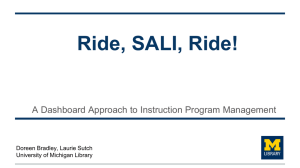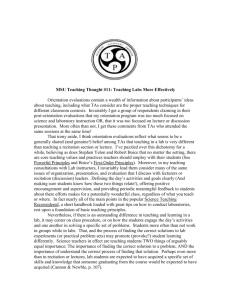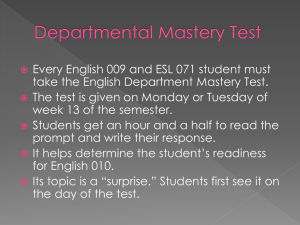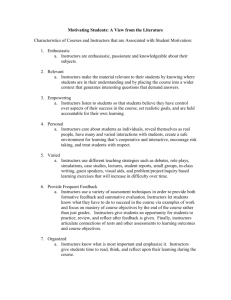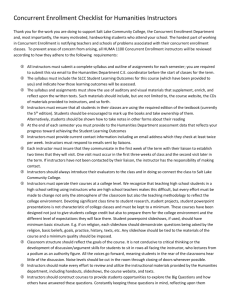Development of Training and Support Programs for Distance
advertisement
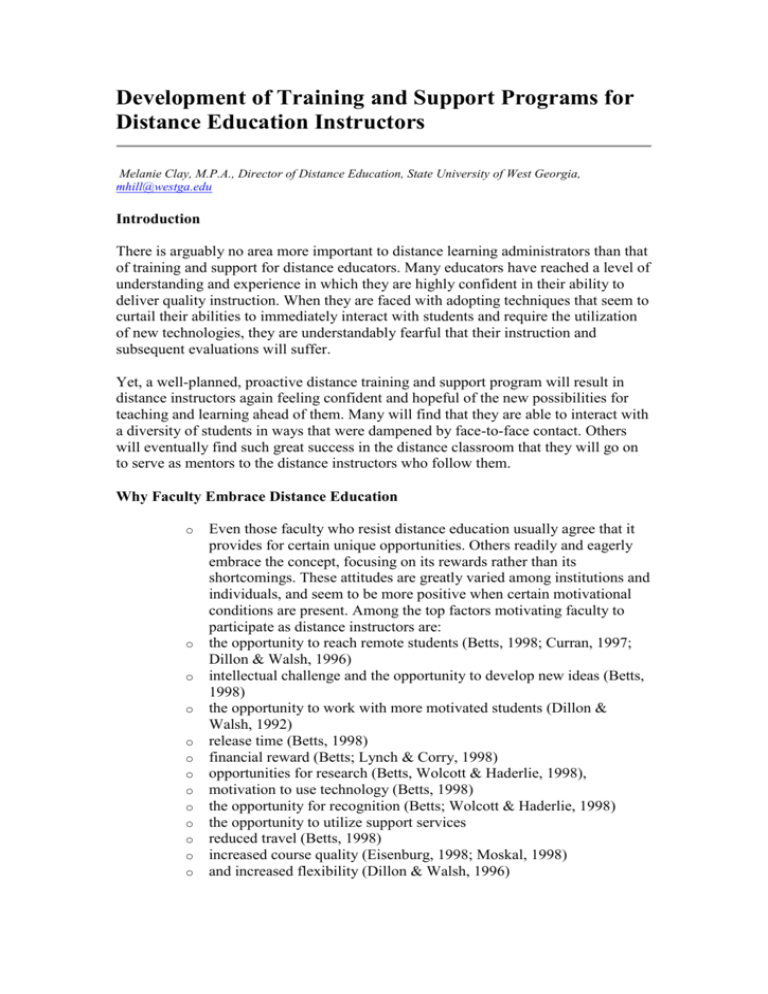
Development of Training and Support Programs for Distance Education Instructors Melanie Clay, M.P.A., Director of Distance Education, State University of West Georgia, mhill@westga.edu Introduction There is arguably no area more important to distance learning administrators than that of training and support for distance educators. Many educators have reached a level of understanding and experience in which they are highly confident in their ability to deliver quality instruction. When they are faced with adopting techniques that seem to curtail their abilities to immediately interact with students and require the utilization of new technologies, they are understandably fearful that their instruction and subsequent evaluations will suffer. Yet, a well-planned, proactive distance training and support program will result in distance instructors again feeling confident and hopeful of the new possibilities for teaching and learning ahead of them. Many will find that they are able to interact with a diversity of students in ways that were dampened by face-to-face contact. Others will eventually find such great success in the distance classroom that they will go on to serve as mentors to the distance instructors who follow them. Why Faculty Embrace Distance Education o o o o o o o o o o o o o Even those faculty who resist distance education usually agree that it provides for certain unique opportunities. Others readily and eagerly embrace the concept, focusing on its rewards rather than its shortcomings. These attitudes are greatly varied among institutions and individuals, and seem to be more positive when certain motivational conditions are present. Among the top factors motivating faculty to participate as distance instructors are: the opportunity to reach remote students (Betts, 1998; Curran, 1997; Dillon & Walsh, 1996) intellectual challenge and the opportunity to develop new ideas (Betts, 1998) the opportunity to work with more motivated students (Dillon & Walsh, 1992) release time (Betts, 1998) financial reward (Betts; Lynch & Corry, 1998) opportunities for research (Betts, Wolcott & Haderlie, 1998), motivation to use technology (Betts, 1998) the opportunity for recognition (Betts; Wolcott & Haderlie, 1998) the opportunity to utilize support services reduced travel (Betts, 1998) increased course quality (Eisenburg, 1998; Moskal, 1998) and increased flexibility (Dillon & Walsh, 1996) The concept of faculty flexibility is a particularly significant factor in motivating professors to teach via distance media, particularly with asynchronous forms. Online learning provides faculty with the same anytime, anyplace experience that makes distance learning attractive to students (Eisenburg, 1998). This flexibility and reduction in travel allows factuly to spend more time with their families or in personal interests (InnoVisions Canada, 1997) and enables them to be away for research, conferences, or personal travel without having to interrupt class (Lynch & Corry, 1998). While resistors to distance instruction argue that course quality is compromised, other faculty are actually drawn to it in part because of the unique opportunities it provides. In certain distance media, such as online learning, students who might normally be withdrawn in a traditional class find the nonverbal interaction less intimidating. In many cases, instructors in online courses find that interaction actually increases because most students, including those who do not normally participate in class, are comfortable asking questions and making comments through email (Hardin, 1998). Why Faculty Resist Distance Teaching Distance instruction represents a tremendous change in the role of instruction. In the distance environment, the instructor shifts more toward a mentor or facilitator role. This requires a great deal of communication, usually through the use of technology. The use of technology, which may be poorly understood by many faculty, results in a substantial increase in the time required to develop and deliver a course. Too often, faculty perceive that this additional investment gives them little or no return in terms of support, recognition, or compensation. Because the success of any institutional distance program depends on the attitudes of faculty, understanding and addressing these issues which concern distance faculty is a significant priority for distance administrators. The primary factors inhibiting faculty from teaching via distance as identified in the literature were: 1. increased workload (Betts, 1998; Dillon & Walsh, 1992; Eisenburg, 1998) , 2. the altered role of the instructor (Dooley, (n.d.); Kaiser, 1998), 3. lack of technical and administrative support (Betts, 1998; Clark, 1993) 4. reduced course quality (Betts, 1998; Clark, 1993) 5. and negative attitudes of colleagues (Moore, 1997). Stages of Faculty Development Staff development in distance education is a continual process of addressing faculty concerns. Hall and Loukes (1979) described seven levels of concern that teachers experience as they adopt a new practice. Loosely based on this model, a sequential process for the stages of development for distance faculty may be construed (see Table 1). In the first stage (awareness), instructors who are considering teaching via the internet commonly begin asking questions about distance learning. At this level, faculty may hear that other instructors in their area are offering all or parts of their courses through distance media, but are really unsure as to how and why this is accomplished. During this stage, instructors need general information, through workshops or printed material, which provides them with clear information about distance learning. As these instructors learn more about distance learning, they reach the stage of consideration. During this time instructors usually decide whether or not distance teaching is for them. They commonly question the benefits and quality of distance teaching and begin to consider whether or not the benefits are worth the efforts. Consultation and dialogue with other instructors who have taught via distance and detailed information about support available to them is critical at this stage. Those instructors who decide to pursue distance instruction move on to the implementation stage. At this time, they may find themselves overwhelmed with the demands of preparing and training for distance course delivery. It is in this stage where the majority of training and support should take place. Instructors commonly look for answers to details such as how to test students, how to develop a backup plan, and how much assistance they can receive. These instructors will generally attempt to conform to the proven methods learned through training and from other instructors. If assistance in this stage is lacking, many instructors will fail to go on to the last stage and will declare that distance teaching is not for them. The time spent in this stage will vary greatly among instructors, and may range from a few days to several years. Once faculty have gained some experience with teaching via distance, they will move onto the last stage of innovation. These instructors often develop new ways of distance teaching which are eventually used by others, and become models in their departments and colleges. They may also go on to conduct research in distance education or to assist in the training and development of other faculty. Their support needs are less but they do need encouragement and recognition for their efforts. Table 1 illustrates the four stages of faculty development for distance educators and the corresponding concerns and needs. Table 1. Stages of Distance Faculty Development Faculty Stage Awareness Faculty Concerns how distance courses are offered why distance courses are offered how distance program relates to university mission Consideration Faculty Needs quality of distance instruction drawbacks and benefits of distance teaching availability of general information opportunity to separate fact from fiction opportunity to ask questions consultation with experienced distance faculty published research and articles opportunity for assistance Implementation hands-on practice time course design student interaction quality standards coaching from other faculty one-on-one intensive training and course development support incentives job-imbedded opportunities Innovation improvement contribution recognition opportunities to assist and mentor others recognition ongoing training and follow-up Types of Effective Training for Distance Instructors Training programs must be designed to meet the needs of persons with a variety of learning styles. While many instructors will learn well from group training sessions, others will do better with self-paced printed materials. Ideally, a training program will include opportunities for at least four types of the following training: o o o o o o o o group sessions; one-on-one lab sessions; web-based tutorials; printed materials; listservs; mentorships; monthly discussion sessions among peers; observation of other distance courses. Of all these, one-on-one training is probably the most effective for most instructors in that it enables them to progress at their own pace while giving them a feeling of dedicated support. Yet, one-on-one training is costly and expensive, and should be reserved mainly for those instructors who have expressed a positive willingness to teach at a distance. While group workshops don't focus on individual needs, they do hold down costs and provide a chance for a sharing of ideas. Group workshops can be enhanced by providing participants into smaller groups based on their level of knowledge and interest. Content of Training Training for distance instructors is a continuous process. Experience shows that training simply won't "take hold" unless support is ongoing, with job-embedded opportunities for practice. Not only do faculty literally forget what they have learned, but often the technology changes as do student and faculty needs. Training for beginning distance instructors should include the following at a minimum: o o o o o o o o an opportunity for addressing concerns; distance learning technology and its impact on learners; availability of administrative and support services; fundamentals of and assistance with course development and adaptation; techniques for encouraging interaction; development of back-up and contingency plans; how distance instruction ties in with the institutional mission; and copyright and other policy issues. In addition to instruction on the use of distance technologies, many faculty will need supporting courses in basic computer utilization, web page production, and development of instructional materials. Once instructors become more comfortable with the basics, other elements of training may include: o o o o o management of problem behaviors in a distance class; needs assessments for distance instruction; practical tips; behind-the-scenes look at student perspective; and how to vary the instructional mix. Level of Course Support Offered As mentioned earlier, one of the factors motivating some faculty to become involved as distance instructors is the availability of support services. Depending on the resources available and the size of the distance staff, support services may include a student assistant, uploading of course materials, creation of online quizzes, development of graphics, test proctoring, and much more. Although these services are critical to a beginning distance instructor, most institutions do not have the resources available to provide an endless array of support services for an infinite amount of time. Furthermore, a true understanding of the technologies involved through handson practice will usually result in an instructor's feeling more confident, and thus providing a course of higher quality. For these reasons, institutions may limit the availability of certain support resources. At the State University of West Georgia, instructors receive full support in course development, entering student names online, uploading pictures, etc. only during the instructor's first online course. For subsequent support in these areas, instructors are required to come to the lab for assistance so that are eventually enabled to perform these tasks themselves or to train a personal assistant or secretary. Five Common Mistakes of New Distance Instructors Many instructors who are highly-esteemed and receive positive evaluations from students in a traditional classroom nevertheless find difficulty in adapting their style to a distance learning format. Some common mistakes of new distance instructors are: 1. Using cutting-edge technologies when simple measures would suffice. For example, instructors are often tempted to put Powerpoint slides on internet courses when text alone would accomplish the same goal. While PowerPoint may work great on fast campus networks, it often runs, very, very slowly for students using home computers with modems. Fancy graphics, audio, or video without a real purpose also result in frustration and a lack of learning for students. 2. Putting the textbook online. The purpose of an online course is not to replace the textbook. Besides violating copyright laws, instructors are doing students a disservice by forcing them to read long pages of text on a computer screen. The internet should be used as a means of interaction and resource sharing. 3. Failing to develop structure and clear requirements. In order for students to participate, they must receive clear expectations from their instructors. Saying "every student must post to the bulletin board at least twice per week," works better than saying "be sure to use the bulletin board for interaction." 4. Not taking time to learn the technology. Students are more apt to use technology effectively when instructors have the confidence to answer most of their questions and understand their concerns. By practicing and mastering the technologies, instructors are able to go beyond the basic features and maximize the effectiveness of their courses. Instructors will also save a lot of time over the long run by being able to quickly make adjustments to their course. 5. Failing to interact with students and follow up regularly. Students feel more connected with instructors who participate regularly, even daily, in bulletin board discussions. Students also expect that their email and phone calls be answered within a day or so. Rewards and Incentives for Distance Instructors Incentives and rewards must be addressed for quality distance programs to succeed. Many faculty teaching distance for the first time quickly lose motivation because recognition systems are lacking (Thach and Murphy, 1994). Although stipends for greater class loads and release time are greatly appreciated, faculty may also be motivated by administrative support, funds to attend related conferences, formal and informal recognition through newsletters, emails, and awards. (Wolcott and Haderlie, 1996) Evaluating Staff Development Staff development programs for distance teaching faculty should be periodically evaluated to determine whether or not to continue the existing training or to modify it. Evaluations should provide answers to specific questions such as whether or not the specific objectives of the staff development have been met and whether or not the training was carried out as intended. Data should be collected on an ongoing basis to assess participant reactions to training, participant learning, and the impact on students. Collected data should be distributed to trainers, distance staff, participants, and decision makers. Various types of evaluation methods may include formative and summative written surveys to determine participant satisfaction with training sessions, written checklists to be completed by trainers, and written or online surveys to determine student satisfaction with courses. References Betts, K. (1998). An institutional overview: Factors influencing faculty participation in distance education in postsecondary education in the United States: An institutional study [on-line]. Online Journal of Distance Learning Administration, 1, 3. Available: http://www.westga.edu/~distance/betts13.html [1998, September 30]. Clark, T. (1993). Attitudes of higher education faculty toward distance education: A national survey. The American Journal of Distance Education, 7 (2), 19-33. Curran, C. (1997). ODL and traditional universities: Dichotomy or convergence? European Journal of Education, 32, 335-346. Dillon, C., & Walsh, S. (1992). Faculty: The neglected resource in distance education. The American Journal of Distance Education, 6 (3), 5-19. Dooley, L. (n.d.). Instructional use of compressed video teleconferencing: A report from faculty users. Available: http://www.music.ecu.edu/DistEd/Video.html [1998, September 19] Eisenberg, D. (1998). College faculty and distance education [on-line]. VUJ Internet Conference, May 1998. Available: http://www.mca.co.uk/services/conferen/may98/vuj/background_paper.htm [1998, September 28]. Hall, G. & Loucks, S. (1979). Implementing innovations in schools: A concerns-based approach. Austin, TX: Research and Development Center for Teacher Education, University of Texas. Hardin, K. (1998). The old teacher in the new classroom: suggestions for effective distance instruction [on-line]. Available http://www.cameron.edu/~karenh/distlearn.html [1998, September 30]. InnoVisions Canada. (1997). Distance education [on-line]. InnoVisons Canada and The Canadian Telework Association. Available: http://www.ivc.ca/part10.html [1998, September 21] Kaiser, J. (1998). Virtual U. talk worries faculty. Science, 280, 2019. Lynch, W. and Corry, M. (1998). Faculty recruitment, training, and compensation for distance education [on-line]. Available: http://www.coe.uh.edu/insite/elect_pub/HTML1998/de_lync.htm [1998, September 30]. Moore, S. (1997). The role of the teacher in distance education: A teacher perspective. Paper presented at the Sixth Annual International Conference for Community & Technical College Chairs, Deans, and Other Organizational Leaders, February 12-15, 1997, Reno, Nevada. Moskal, P., Dzruiban, C., & Moskal, P. (1998). Faculty go on-line: Impressions of faculty teaching web and web-enhanced courses. Paper presented at Educom 98, Orlando, October 17, 1998. Wolcott, L., & Haderlie, S. (1996). Institutional support for distance teaching: A study of reward practices. The Distance Educator, 2 (3), 2-5. Online Journal of Distance Learning Administration, Volume II, Number III, Fall1999 State University of West Georgia, Distance Education Back to Journal of Distance Learning Administration Contents
